Mural Wall:
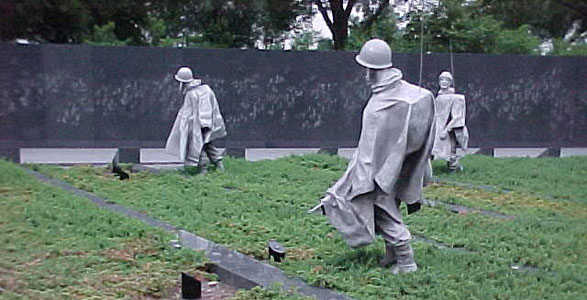
 The Mural Wall was designed by Louis Nelson, of New York, N.Y., and fabricated by Cold Spring Granite Company, Cold Spring, MN. The mural is 164 feet long and consists of approximately 2,400 images depicting Army, Navy, Marine Corps, Air Force, and Coast Guard personnel and their equipment.
The Mural Wall was designed by Louis Nelson, of New York, N.Y., and fabricated by Cold Spring Granite Company, Cold Spring, MN. The mural is 164 feet long and consists of approximately 2,400 images depicting Army, Navy, Marine Corps, Air Force, and Coast Guard personnel and their equipment.
The images are based on photographs, obtained from the National Archives, taken during the Korean War. The photographs were copied to a computer where the images were enhanced to develop a uniform lighting effect and adjusted to appear to be overlooking the statues of the men they supported. The images were etched into the wall using a sandblasting process.
All names, rank, and company insignia were removed and no records were kept that would allow for specific identification of the images.
The wall is made from Academy Black Granite polished to reflect the statues. The reflection creates an appearance of 38 statues, symbolic of the 38th parallel - the boundary between North and South Korea.
The mural wall is organized by service as shown below:
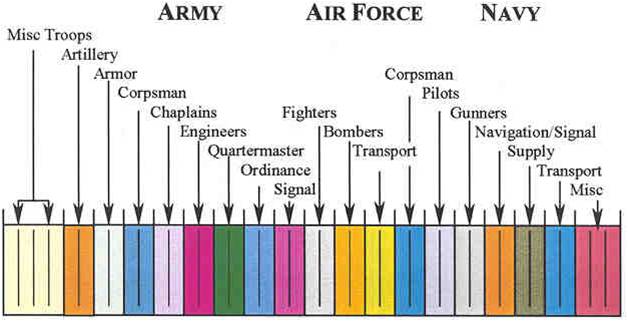
The etchings of the U.S. Army section include: support artillery, rocket launchers, 240mm self-propelled guns, antiaircraft artillery, projectiles, armored vehicles, tank crewmen, Patton Tanks, M.A.S.H. units, rescue helicopters, surgeons, nurses, ambulances, blood transfusions, stretcher bearers, chaplains representing all denominations, mine clearing, bridge building, road and airfield construction, supply centers, ammunition and fuel dumps, placing communication lines, switchboards and radio communications.
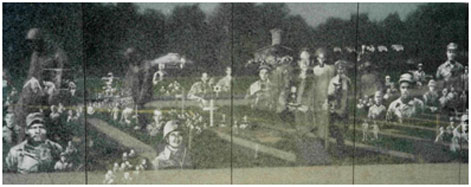
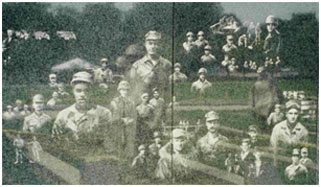
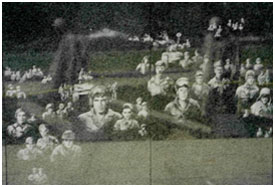
The U.S. Air Force section includes: air-ground controllers, AT-6's, F-80's, F-86's, P-51's, C-47's, C-97's pilots, crewmen bombs, air evacuation, paratroopers, airborne assaults and aerial re-supply.

The U.S. Navy section includes: air evacuation, hospital ships, iron lung, air landing officer, Corsair pilots, submarines, Seabees, landing forces, ships: APA's, AKA's, LC1's, LCVP's.


The miscellaneous section includes: POW handing, traffic control, military police, Red Cross, canine corps, KATUSA's (Koreans attached to the U.S. Army), photographers, reporters and a shrine.
Hibiscus Plantings:
To the south of the Memorial are three beds of Rose of Sharon hibiscus plants. This plant is the national flower of South Korea.
Pool of Remembrance:
Honoring the dead, the missing, the POW's and the wounded from the United States and United Nations Forces ... statistics engraved in stone ... walk out into the pool area on a peninsula symbolic of the Republic of Korea, which is a peninsula.
United Nations Curb:
Twenty-two nations responded to the United Nations call to defend freedom and repel the communist aggression...names of all nations are engraved on the curb stone along the north entrance. Seventeen nations provided combat units, five provided medical support.
Honor Roll:
The Honor Roll contains all verifiable names of those on active duty who were killed in action, still listed as missing in action, and captured as prisoners of war in the Korean War (these names come from the National Archives, the Department of Defense and relatives). Those who died elsewhere while in service to their country in the cause of freedom during the Korean War, June 25, 1950 to July 27, 1953, will also be included if family and friends so request and have verifiable data provided to the American Battle Monuments Commission.
History:
On June 25, 1950, the North Korean offensive started from four locations across the 38th parallel into South Korea. In 41 days, the South Korean and American forces would be driven back into the Pusan perimeter, just a few miles from the southern shore of the tip of South Korea. In August, reinforcements from the Eighth Army and Marine Corps arrived.
By the end of September, the Eighth Army broke out of the Pusan perimeter while Infantry and Marine Corps landed at Inchon and liberated Seoul, the capital of South Korea.
Three months later Marines, forward details from the Army and other British, French, Turkish, South Korean and other United Nations forces would stand at the Yalu River, the border between Korea and China, thinking the war was nearly over. Soon after reaching the border, a force of 300,000 Chinese troops who had moved into North Korea during the United Nations advance and concealed themselves in the mountainous terrain, attacked the United Nations forces from the rear. The United Nations forces would soon be fighting their way back to the coast to be taken off by the Navy or to secure positions in the south. The next 2-1/2 years of the conflict would become trench warfare or battles for hilltops fought back and forth across the 38th parallel.
During the war. several decisions were made that would set the course of World history. Prior to the conflict, America was disarming from World War II, ignoring the communist threat. After the North Korean invasion, President Truman set the doctrine that no country would fall to communism. It marked the beginning of the end of the Soviet Union and established our industrial base for the next 50 years.
Message: "FREEDOM IS NOT FREE"...Takes legions of men and women who fight a war against oppression ... a memorial of faces, complimenting the memorial of names across the reflecting pool...
"OUR NATION HONORS HER SONS AND DAUGHTERS WHO ANSWERED THE CALL TO DEFEND A COUNTRY THEY NEVER KNEW AND A PEOPLE THEY NEVER MET"
POC: Jon Sadler